Yingzhen Yang
Differentiable Channel Selection in Self-Attention For Person Re-Identification
May 13, 2025Abstract:In this paper, we propose a novel attention module termed the Differentiable Channel Selection Attention module, or the DCS-Attention module. In contrast with conventional self-attention, the DCS-Attention module features selection of informative channels in the computation of the attention weights. The selection of the feature channels is performed in a differentiable manner, enabling seamless integration with DNN training. Our DCS-Attention is compatible with either fixed neural network backbones or learnable backbones with Differentiable Neural Architecture Search (DNAS), leading to DCS with Fixed Backbone (DCS-FB) and DCS-DNAS, respectively. Importantly, our DCS-Attention is motivated by the principle of Information Bottleneck (IB), and a novel variational upper bound for the IB loss, which can be optimized by SGD, is derived and incorporated into the training loss of the networks with the DCS-Attention modules. In this manner, a neural network with DCS-Attention modules is capable of selecting the most informative channels for feature extraction so that it enjoys state-of-the-art performance for the Re-ID task. Extensive experiments on multiple person Re-ID benchmarks using both DCS-FB and DCS-DNAS show that DCS-Attention significantly enhances the prediction accuracy of DNNs for person Re-ID, which demonstrates the effectiveness of DCS-Attention in learning discriminative features critical to identifying person identities. The code of our work is available at https://github.com/Statistical-Deep-Learning/DCS-Attention.
Diffusion on Graph: Augmentation of Graph Structure for Node Classification
Mar 16, 2025Abstract:Graph diffusion models have recently been proposed to synthesize entire graphs, such as molecule graphs. Although existing methods have shown great performance in generating entire graphs for graph-level learning tasks, no graph diffusion models have been developed to generate synthetic graph structures, that is, synthetic nodes and associated edges within a given graph, for node-level learning tasks. Inspired by the research in the computer vision literature using synthetic data for enhanced performance, we propose Diffusion on Graph (DoG), which generates synthetic graph structures to boost the performance of GNNs. The synthetic graph structures generated by DoG are combined with the original graph to form an augmented graph for the training of node-level learning tasks, such as node classification and graph contrastive learning (GCL). To improve the efficiency of the generation process, a Bi-Level Neighbor Map Decoder (BLND) is introduced in DoG. To mitigate the adverse effect of the noise introduced by the synthetic graph structures, a low-rank regularization method is proposed for the training of graph neural networks (GNNs) on the augmented graphs. Extensive experiments on various graph datasets for semi-supervised node classification and graph contrastive learning have been conducted to demonstrate the effectiveness of DoG with low-rank regularization. The code of DoG is available at https://github.com/Statistical-Deep-Learning/DoG.
Gradient Descent Finds Over-Parameterized Neural Networks with Sharp Generalization for Nonparametric Regression: A Distribution-Free Analysis
Nov 05, 2024Abstract:We study nonparametric regression by an over-parameterized two-layer neural network trained by gradient descent (GD) in this paper. We show that, if the neural network is trained by GD with early stopping, then the trained network renders a sharp rate of the nonparametric regression risk of $\cO(\eps_n^2)$, which is the same rate as that for the classical kernel regression trained by GD with early stopping, where $\eps_n$ is the critical population rate of the Neural Tangent Kernel (NTK) associated with the network and $n$ is the size of the training data. It is remarked that our result does not require distributional assumptions on the training data, in a strong contrast with many existing results which rely on specific distributions such as the spherical uniform data distribution or distributions satisfying certain restrictive conditions. The rate $\cO(\eps_n^2)$ is known to be minimax optimal for specific cases, such as the case that the NTK has a polynomial eigenvalue decay rate which happens under certain distributional assumptions. Our result formally fills the gap between training a classical kernel regression model and training an over-parameterized but finite-width neural network by GD for nonparametric regression without distributional assumptions. We also provide confirmative answers to certain open questions or address particular concerns in the literature of training over-parameterized neural networks by GD with early stopping for nonparametric regression, including the characterization of the stopping time, the lower bound for the network width, and the constant learning rate used in GD.
Locally Regularized Sparse Graph by Fast Proximal Gradient Descent
Sep 25, 2024Abstract:Sparse graphs built by sparse representation has been demonstrated to be effective in clustering high-dimensional data. Albeit the compelling empirical performance, the vanilla sparse graph ignores the geometric information of the data by performing sparse representation for each datum separately. In order to obtain a sparse graph aligned with the local geometric structure of data, we propose a novel Support Regularized Sparse Graph, abbreviated as SRSG, for data clustering. SRSG encourages local smoothness on the neighborhoods of nearby data points by a well-defined support regularization term. We propose a fast proximal gradient descent method to solve the non-convex optimization problem of SRSG with the convergence matching the Nesterov's optimal convergence rate of first-order methods on smooth and convex objective function with Lipschitz continuous gradient. Extensive experimental results on various real data sets demonstrate the superiority of SRSG over other competing clustering methods.
Deep Geometric Moments Promote Shape Consistency in Text-to-3D Generation
Aug 12, 2024



Abstract:To address the data scarcity associated with 3D assets, 2D-lifting techniques such as Score Distillation Sampling (SDS) have become a widely adopted practice in text-to-3D generation pipelines. However, the diffusion models used in these techniques are prone to viewpoint bias and thus lead to geometric inconsistencies such as the Janus problem. To counter this, we introduce MT3D, a text-to-3D generative model that leverages a high-fidelity 3D object to overcome viewpoint bias and explicitly infuse geometric understanding into the generation pipeline. Firstly, we employ depth maps derived from a high-quality 3D model as control signals to guarantee that the generated 2D images preserve the fundamental shape and structure, thereby reducing the inherent viewpoint bias. Next, we utilize deep geometric moments to ensure geometric consistency in the 3D representation explicitly. By incorporating geometric details from a 3D asset, MT3D enables the creation of diverse and geometrically consistent objects, thereby improving the quality and usability of our 3D representations.
IDNet: A Novel Dataset for Identity Document Analysis and Fraud Detection
Aug 03, 2024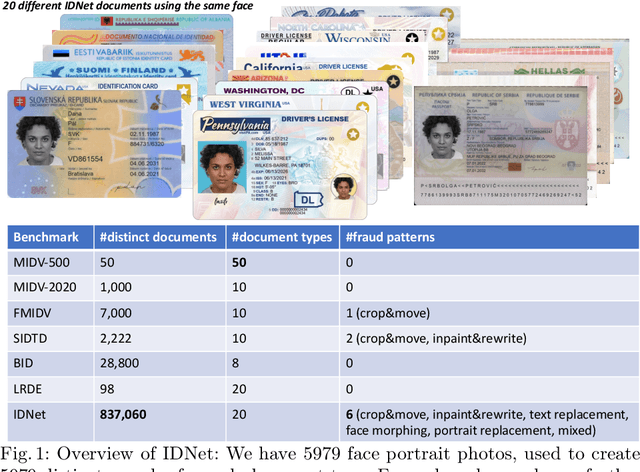
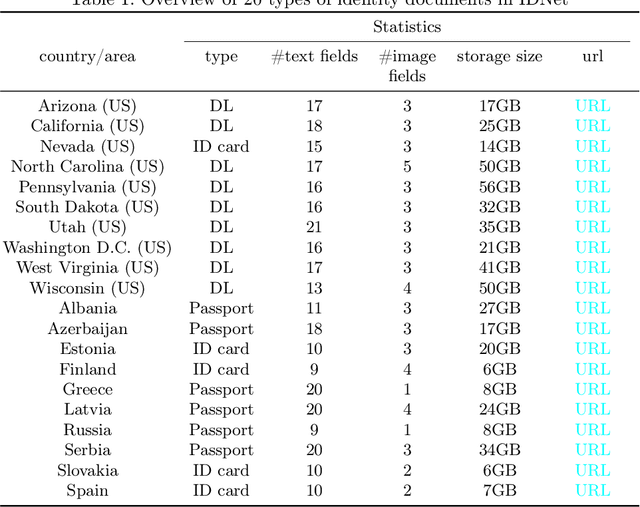
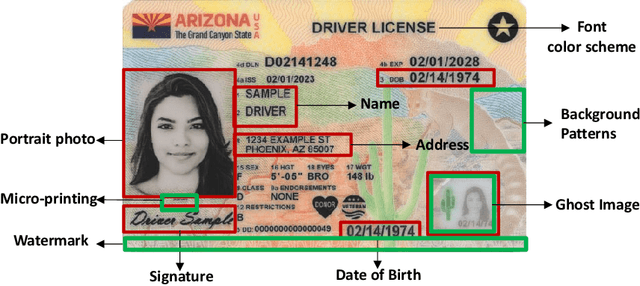

Abstract:Effective fraud detection and analysis of government-issued identity documents, such as passports, driver's licenses, and identity cards, are essential in thwarting identity theft and bolstering security on online platforms. The training of accurate fraud detection and analysis tools depends on the availability of extensive identity document datasets. However, current publicly available benchmark datasets for identity document analysis, including MIDV-500, MIDV-2020, and FMIDV, fall short in several respects: they offer a limited number of samples, cover insufficient varieties of fraud patterns, and seldom include alterations in critical personal identifying fields like portrait images, limiting their utility in training models capable of detecting realistic frauds while preserving privacy. In response to these shortcomings, our research introduces a new benchmark dataset, IDNet, designed to advance privacy-preserving fraud detection efforts. The IDNet dataset comprises 837,060 images of synthetically generated identity documents, totaling approximately 490 gigabytes, categorized into 20 types from $10$ U.S. states and 10 European countries. We evaluate the utility and present use cases of the dataset, illustrating how it can aid in training privacy-preserving fraud detection methods, facilitating the generation of camera and video capturing of identity documents, and testing schema unification and other identity document management functionalities.
Efficient Visual Transformer by Learnable Token Merging
Jul 21, 2024



Abstract:Self-attention and transformers have been widely used in deep learning. Recent efforts have been devoted to incorporating transformer blocks into different neural architectures, including those with convolutions, leading to various visual transformers for computer vision tasks. In this paper, we propose a novel and compact transformer block, Transformer with Learnable Token Merging (LTM), or LTM-Transformer. LTM-Transformer performs token merging in a learnable scheme. LTM-Transformer is compatible with many popular and compact transformer networks, and it reduces the FLOPs and the inference time of the visual transformers while maintaining or even improving the prediction accuracy. In the experiments, we replace all the transformer blocks in popular visual transformers, including MobileViT, EfficientViT, ViT-S/16, and Swin-T, with LTM-Transformer blocks, leading to LTM-Transformer networks with different backbones. The LTM-Transformer is motivated by reduction of Information Bottleneck, and a novel and separable variational upper bound for the IB loss is derived. The architecture of mask module in our LTM blocks which generate the token merging mask is designed to reduce the derived upper bound for the IB loss. Extensive results on computer vision tasks evidence that LTM-Transformer renders compact and efficient visual transformers with comparable or much better prediction accuracy than the original visual transformers. The code of the LTM-Transformer is available at \url{https://github.com/Statistical-Deep-Learning/LTM}.
Preconditioned Gradient Descent Finds Over-Parameterized Neural Networks with Sharp Generalization for Nonparametric Regression
Jul 16, 2024
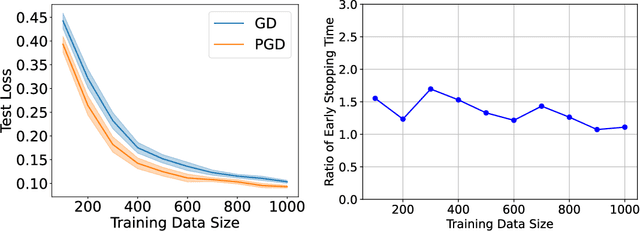
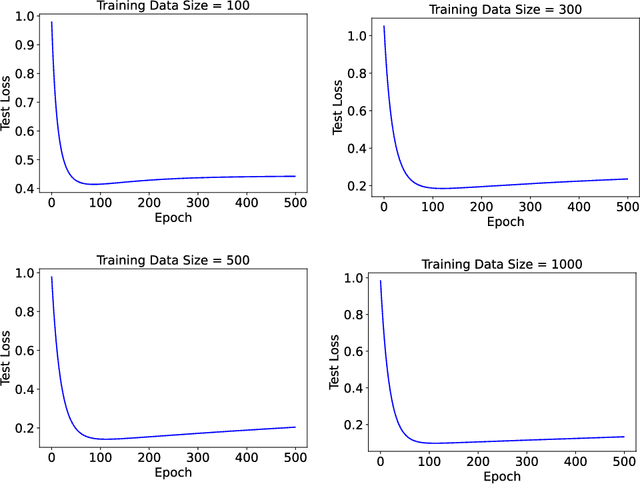

Abstract:We consider nonparametric regression by an over-parameterized two-layer neural network trained by gradient descent (GD) or its variant in this paper. We show that, if the neural network is trained with a novel Preconditioned Gradient Descent (PGD) with early stopping and the target function has spectral bias widely studied in the deep learning literature, the trained network renders a particularly sharp generalization bound with a minimax optimal rate of $\cO({1}/{n^{4\alpha/(4\alpha+1)}})$, which is sharper the current standard rate of $\cO({1}/{n^{2\alpha/(2\alpha+1)}})$ with $2\alpha = d/(d-1)$ when the data is distributed uniformly on the unit sphere in $\RR^d$ and $n$ is the size of the training data. When the target function has no spectral bias, we prove that neural network trained with regular GD with early stopping still enjoys minimax optimal rate, and in this case our results do not require distributional assumptions in contrast with the current known results. Our results are built upon two significant technical contributions. First, uniform convergence to the NTK is established during the training process by PGD or GD, so that we can have a nice decomposition of the neural network function at any step of GD or PGD into a function in the RKHS and an error function with a small $L^{\infty}$-norm. Second, local Rademacher complexity is employed to tightly bound the Rademacher complexity of the function class comprising all the possible neural network functions obtained by GD or PGD. Our results also indicate that PGD can be another way of avoiding the usual linear regime of NTK and obtaining sharper generalization bound, because PGD induces a different kernel with lower kernel complexity during the training than the regular NTK induced by the network architecture trained by regular GD.
Low-Rank Graph Contrastive Learning for Node Classification
Feb 14, 2024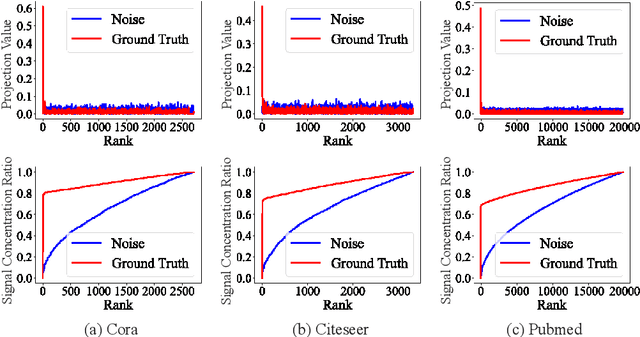

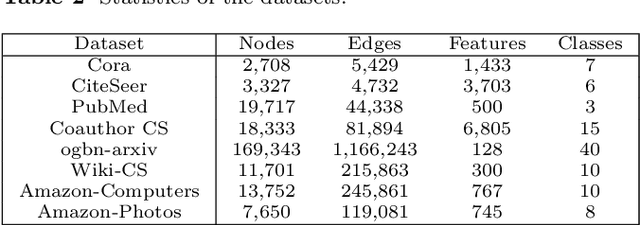
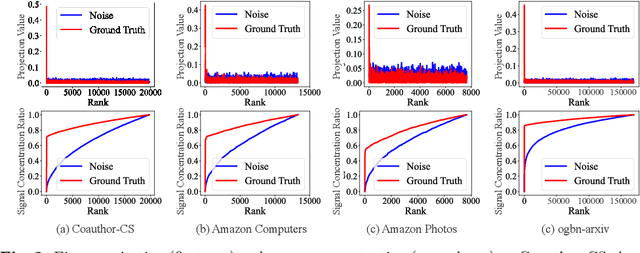
Abstract:Graph Neural Networks (GNNs) have been widely used to learn node representations and with outstanding performance on various tasks such as node classification. However, noise, which inevitably exists in real-world graph data, would considerably degrade the performance of GNNs revealed by recent studies. In this work, we propose a novel and robust GNN encoder, Low-Rank Graph Contrastive Learning (LR-GCL). Our method performs transductive node classification in two steps. First, a low-rank GCL encoder named LR-GCL is trained by prototypical contrastive learning with low-rank regularization. Next, using the features produced by LR-GCL, a linear transductive classification algorithm is used to classify the unlabeled nodes in the graph. Our LR-GCL is inspired by the low frequency property of the graph data and its labels, and it is also theoretically motivated by our sharp generalization bound for transductive learning. To the best of our knowledge, our theoretical result is among the first to theoretically demonstrate the advantage of low-rank learning in graph contrastive learning supported by strong empirical performance. Extensive experiments on public benchmarks demonstrate the superior performance of LR-GCL and the robustness of the learned node representations. The code of LR-GCL is available at \url{https://anonymous.4open.science/r/Low-Rank_Graph_Contrastive_Learning-64A6/}.
A Learning-based Declarative Privacy-Preserving Framework for Federated Data Management
Jan 22, 2024Abstract:It is challenging to balance the privacy and accuracy for federated query processing over multiple private data silos. In this work, we will demonstrate an end-to-end workflow for automating an emerging privacy-preserving technique that uses a deep learning model trained using the Differentially-Private Stochastic Gradient Descent (DP-SGD) algorithm to replace portions of actual data to answer a query. Our proposed novel declarative privacy-preserving workflow allows users to specify "what private information to protect" rather than "how to protect". Under the hood, the system automatically chooses query-model transformation plans as well as hyper-parameters. At the same time, the proposed workflow also allows human experts to review and tune the selected privacy-preserving mechanism for audit/compliance, and optimization purposes.
 Add to Chrome
Add to Chrome Add to Firefox
Add to Firefox Add to Edge
Add to Edge